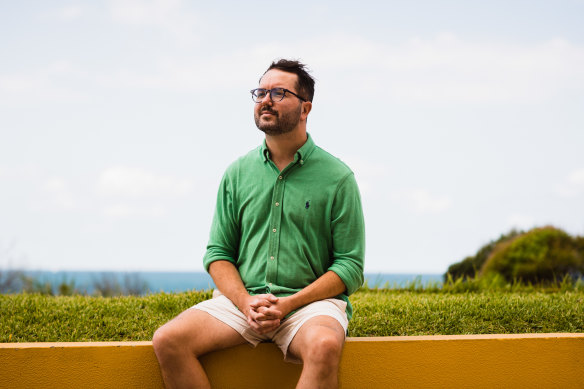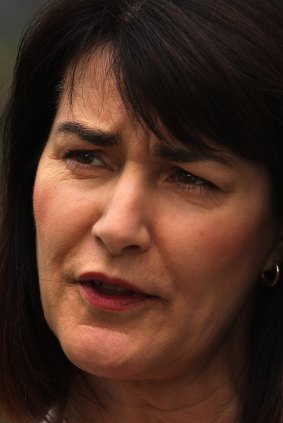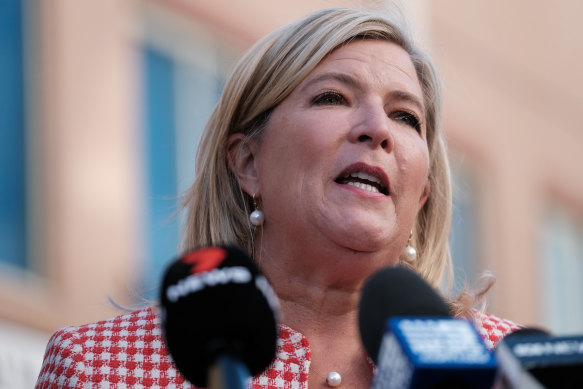- Exclusive
- National
- NSW
- Mental health
This was published 1 year ago
‘Forgotten’ hallucinating patient left in small hospital room for hours
By Anna Patty and Kate Aubusson
Joel MacKay has lost count of how many times he has tried to end his life. He was hallucinating and hearing voices in his head during the hours he spent waiting for treatment in a hospital emergency department before he went home in an Uber.
A new alliance of psychiatrists, nurses, GPs and other health professionals will release a landmark report on Tuesday which exposes a deepening crisis in mental health care. It finds that in some cases, like MacKay’s, the under-resourced public health system can end up causing more stress for the patient than the mental health condition it is meant to treat.

Joel MacKay, from Cronulla, has Schizoaffective Bipolar Disorder. Credit: James Brickwood
“Too many Australians are falling through the cracks, and their trauma isn’t dealt with,” the report concludes. “In fact, they’re often retraumatised by the system.”
Royal Australia and New Zealand College of Psychiatrists (RANZCP) chair Dr Angelo Virgona said the report is a document of despair. “Mental health workers across the state describe a system that’s too complex, too hard to access, fragmented and weighed down by inequality,” he said.
Where services do exist, they were hard to access because of long wait times or restrictive entry criteria. The report said people were “falling through the cracks and left adrift in an already stretched public health system, presenting at emergency departments, a most incongruent setting for a mental health assessment for someone in distress”.
Since August last year, 34-year-old MacKay, who has struggled with the cost of private care, has been on nine different waiting lists to see a psychologist and psychiatrist in the Sutherland Shire for treatment of his Schizoaffective Bipolar disorder. “I’m not a priority unfortunately,” he said.
‘I felt like I was forgotten and staff weren’t really checking on me. I was in there for hours and hours.’
Joel MacKay, who has Schizoaffective Bipolar Disorder
His only option to get more urgent treatment is at a hospital emergency department. On one occasion, he waited about four hours in a small dark room for a hospital bed before going home, only to return a few days later in a worse condition.
“I was in a little room by myself, doors shut, curtains drawn, lights off. I was just told to sit there,” he said.
“I felt like I was forgotten and staff weren’t really checking on me. I was in there for hours and hours ... and when it was clear there was no bed to go to they didn’t know what to do with me so the best thing I could do was ... catch an Uber home. And I ended up being hospitalised a few days later.”
The NSW Branch RANZCP, in partnership with an alliance of peak health and mental health groups, surveyed more than 1300 frontline mental health specialists and workers who have witnessed patients being denied timely access to affordable mental health care. The report found a system that is chronically underfunded, too expensive to access for many and unfit for purpose.
One health worker said: “People are presenting to emergency with mental health issues and being turned back out onto the street/home. We need to have closer monitoring of these situations as two out of three cases I have had personal dealings with ended in suicide”. Another said a patient whose family struggled for years to get care him ended up in hospital for five years after burning himself in community housing and refusing medical treatment.
One community mental health worker said: “public hospitals are doing very little for mental health patients, other than keep them alive. Patients are fearful and resist admission as they feel hospitalisations are unhelpful, if not damaging (traumatising). A psychiatrist said: “We are the only profession that ends up having to prescribe or recommend treatments that are outside best guidelines because we have to use whatever we can muster.“
Carmel Tebbutt, chief executive officer for the Mental Health Coordinating Council, said emergency departments across NSW had become the “default access point into the mental health system”.

Mental Health Coordinating Council boss Carmel Tebbutt says too many patients have to use hospitals to access the system.Credit: Kate Geraghty
“Far too many people are missing out on vital mental health services delivered by community organisations,” she said.
“We need systemic and structural change that increases investment in community mental health services to meet the needs of people experiencing mental health distress who cannot get support.”
The Australian Productivity Commission reported in 2020-21 that NSW was spending less per person on mental health than other states and territories and that gap was set to widen since Queensland and Victoria had provided more funding for their mental health services.
A spokesman for NSW Labor said if it wins government on March 25 it will expand Lifeline services and spend $17 million to improve access to mental health services for young people in NSW through the Kids Helpline.
“NSW Labor will also establish legislation to enshrine a whole-of-government approach to suicide prevention,” the spokesman said.

Mental Health Minister Bronnie Taylor says the NSW government has invested in the state’s mental health system.Credit: Oscar Colman
A spokesman for Mental Health Minister Bronnie Taylor said a re-elected Coalition government would work with the sector to ensure the mental health system meets the needs of consumers and would consider a system gap analysis to identify any shortfalls.
“The NSW government has undertaken significant investment into the mental health system over the past 10 years,” the spokesman said. This included new initiatives to boost mental health care for children and adults in the community, including suicide prevention services.
Crisis support is available from Lifeline on 13 11 14 and Beyond Blue on 1300 22 4636.
The Morning Edition newsletter is our guide to the day’s most important and interesting stories, analysis and insights. Sign up here.